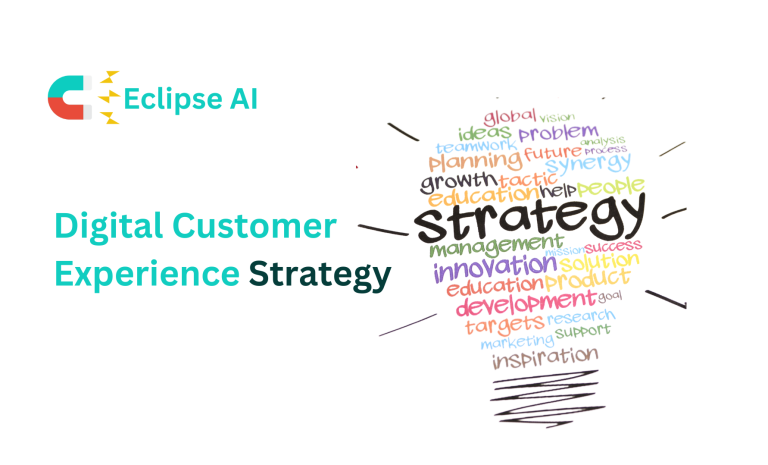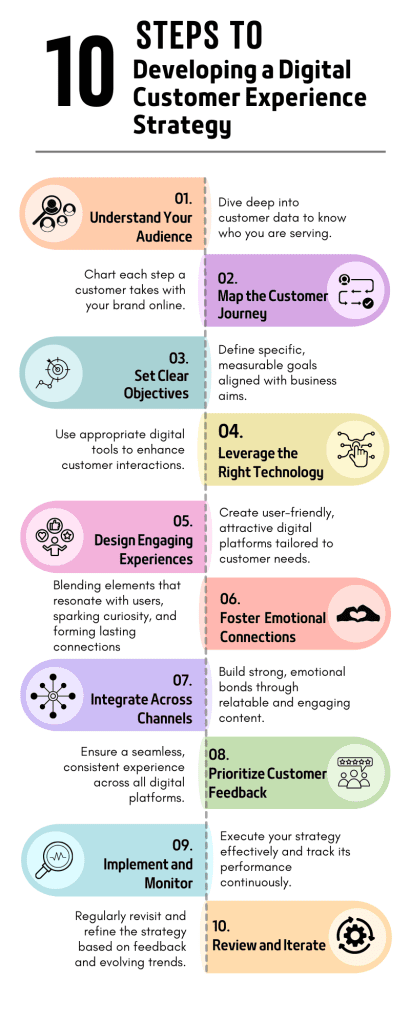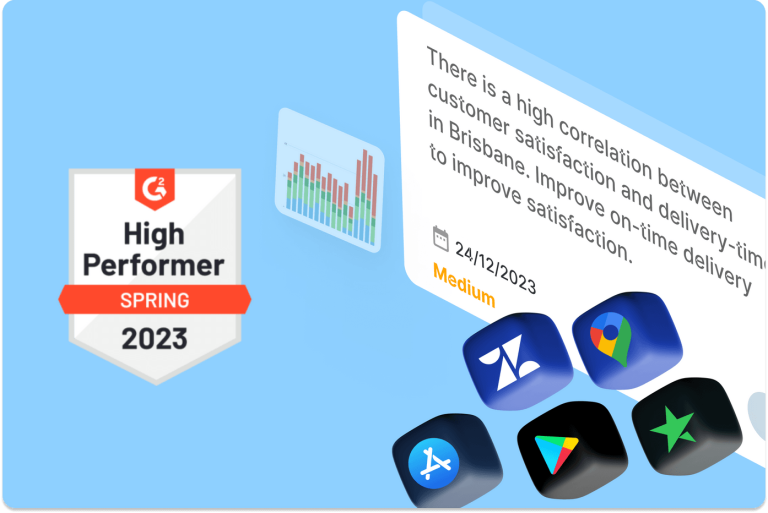

What is Brand Equity and Why Does It Matter?
Have you ever wondered why you’re willing to pay extra for a name-brand product when a generic version exists? That’s the power of brand equity in action!
A strong Digital Customer Experience (DCX) strategy is essential in today’s digital age. This article delves into innovative DCX strategies, highlighting unique insights and methodologies crucial for success in the digital realm.


The digital era has transformed the way businesses interact with their customers. This customer experience transformation is reshaping industries, compelling businesses to rethink their approach to customer engagement and tailor their strategies to meet evolving digital expectations.
Stellar Digital Customer Experience Strategy leads to higher customer loyalty and retention. In a world with many options, a good online experience can make customers want to come back. Having a strong digital customer experience strategy can lead to 89% customer retention, reflecting the importance of having a digital customer experience strategy.
A unique Digital Customer Experience strategy sets your brand apart in a crowded digital marketplace. Interacting with your brand online is not just about the products or services offered, but also how customers feel.
A direct correlation exists between effective DCX strategies and revenue growth. Companies that improve their online customer experiences foster loyalty, drive growth, make more money and have longer-lasting relationships with customers.


A key step in developing a successful Digital Customer Experience (DCX) strategy is to commence with thorough research and data collection. This involves gathering extensive information about both your current and potential customers. Utilize a variety of sources such as market research, customer feedback, social media analytics, and any other relevant data sources. This comprehensive data collection is crucial for gaining a deep understanding of your customer base.
With this wealth of information, the next step is to create detailed customer personas. These personas are crafted based on the collected data and should vividly represent different segments of your audience. Each persona should encompass specific preferences, behaviors, pain points, and digital habits. Developing these personas enables you to tailor your DCX strategy more effectively, ensuring it resonates with and meets the unique needs of each customer segment.
To develop an effective Digital Customer Experience Strategy, it’s crucial to identify and analyze all digital touchpoints where customers interact with your brand. This includes your website, social media platforms, email communications, mobile applications, and online advertising. Understanding these touchpoints provides insight into where and how customers engage with your brand.
Once these touchpoints are identified, use customer journey maps to analyze the current navigation path of your customers. This analysis should focus on understanding how customers move through these touchpoints, pinpointing areas where they have positive experiences as well as identifying points where they encounter challenges. By mapping and analyzing the customer journey in this way, you gain valuable insights into customer behavior and preferences, enabling you to optimize their experience across all digital platforms.
Your Digital Customer Experience (DCX) strategy needs to align closely with your broader business goals. Whether your objectives include boosting sales, enhancing customer retention, or elevating brand recognition, your DCX strategy should be designed to directly support these targets.
To ensure effectiveness, set specific and measurable goals within your DCX plan. This could involve measuring pre-defined KPIs such as aiming to increase website conversion rates by a defined percentage or reaching a particular Net Promoter Score (NPS). By establishing clear, quantifiable objectives, you can more effectively measure the success of your Digital Customer Experience strategy and its impact on your overall business achievements.
To refine your Digital Customer Experience (DCX) strategy, start by evaluating the digital tools and platforms your business currently uses. This assessment should identify any existing gaps and include a review of your CRM systems, marketing automation tools, customer experience analytics tools, and customer service platforms. Understanding where your current setup can be improved is key to enhancing your overall digital customer experience.
Simultaneously, it’s crucial to stay abreast of emerging technologies that have the potential to revolutionize the digital experience. Technologies such as AI, chatbots, and AR/VR are reshaping customer interactions. For instance, AR technology offers customers the opportunity to try products virtually, providing a deeper understanding and enhancing the buying experience. Incorporating these technologies into your DCX strategy not only keeps your approach modern but also significantly improves customer experience and satisfaction.
Related Reading:
The AI Advantage: How AI Enhances Customer Experience at Every Touchpoint
An effective Digital Customer Experience (DCX) strategy prioritizes user-centered design. This means crafting your digital platforms with a keen focus on usability, accessibility, and aesthetic appeal to ensure they are intuitive and engaging for users. By designing with the user in mind, you create a more seamless and enjoyable digital experience.
Complementing this, personalization plays a crucial role in modern DCX strategies. Today’s customers expect shopping experiences that are tailored to their individual preferences and past interactions. Far from being just an added feature, personalization is essential for a fulfilling customer experience. Research from Epsilon indicates that customers who receive personalized experiences are 80% more likely to make a purchase. Integrating personalization into your digital platforms not only meets customer expectations but significantly boosts engagement and conversion rates.
An integral part of a successful Digital Customer Experience (DCX) strategy is creating content that deeply resonates with your audience. Storytelling, as a technique, can be particularly effective in developing relatable content. It’s about crafting narratives that connect with your audience on an emotional level, making your brand more memorable and engaging.
In tandem with relatable content, building a strong community around your brand is essential. Utilize social media and other online platforms to foster spaces where customers can interact with each other and your brand. Engaging in conversations and encouraging community participation enhances customer loyalty and strengthens your brand’s online presence.
Both relatable content and community building are pivotal in creating a more dynamic and interactive digital customer experience. They not only enhance customer engagement but also contribute to a deeper, more meaningful relationship between your customers and your brand.
A cornerstone of an effective Digital Customer Experience (DCX) strategy is the adoption of an omni-channel approach. This involves ensuring a seamless and consistent experience across all digital touchpoints, including apps, websites, and social media platforms. Customers today expect uniformity in their interactions with a brand’s digital presence. Investing in an omnichannel transformation is not just about enhancing customer satisfaction; it also has tangible business benefits, potentially improving revenue growth by 5 to 15%.
In parallel with an omni-channel strategy, it’s crucial to maintain consistent messaging across all platforms. Consistency in your brand’s voice and message reinforces brand identity and aids in building trust with your audience. Whether a customer is browsing your website, using your app, or engaging with your brand on social media, the message and tone should be cohesive and aligned. This approach not only strengthens your brand presence but also ensures a more coherent and satisfying customer experience.
An essential aspect of a robust Digital Customer Experience (DCX) strategy is the ongoing collection and analysis of customer feedback across all digital channels. Regularly engaging in Customer Experience Analytics is crucial for businesses aiming to leave a lasting positive impression on their customers. This constant feedback loop allows for an accurate and up-to-date understanding of customer needs and perceptions.
In conjunction with gathering feedback, the ability to adapt and evolve your strategy is vital. Being responsive to the feedback received and staying attuned to changing market trends are key elements in maintaining a relevant and effective DCX strategy. This approach ensures that your strategy remains dynamic and aligned with customer expectations, allowing for continuous improvement and adaptation to the ever-changing digital landscape.
A pivotal element of an effective Digital Customer Experience (DCX) strategy is the creation of a comprehensive action plan. This plan should detail the implementation steps, along with clear timelines and assigned responsibilities, ensuring that every aspect of your DCX strategy is methodically executed. Having a well-structured plan is crucial for the successful deployment of your digital customer experience initiatives.
Equally important is the regular monitoring of your strategy’s performance. This involves consistently measuring outcomes against your predetermined goals using key metrics and analytics. By regularly assessing performance, you can identify areas of success and pinpoint aspects that require improvement. This ongoing evaluation not only helps in fine-tuning your strategy but also ensures that it remains aligned with your objectives and responsive to customer needs and market dynamics.
To ensure the ongoing success of your Digital Customer Experience (DCX) strategy, it’s essential to conduct regular reviews. These reviews should focus on assessing the effectiveness of your strategy, allowing you to gauge its impact and identify areas that need refinement. This process of continual assessment is crucial in understanding how well your DCX strategy aligns with customer expectations and business objectives.
In addition to regular evaluations, adopting a mindset geared towards continuous improvement is vital. The digital landscape is perpetually evolving, and so should your approach to customer experience. Being open to making adjustments and updates in response to emerging digital trends, customer feedback, and analytical insights ensures that your DCX strategy remains current, effective, and aligned with the latest in digital innovation. This commitment to ongoing enhancement is key to maintaining a competitive edge and delivering a superior customer experience.
A vital aspect of an effective Digital Customer Experience (DCX) strategy is the alignment of customer experience with customer success and support.
This holistic integration ensures that every facet of a customer’s interaction with the brand is meticulously considered and optimized. Such an approach guarantees a comprehensive customer experience, addressing all aspects of customer engagement and support for maximum effectiveness.
Simultaneously, your DCX strategy must be adaptable to different cultural contexts, particularly for businesses operating across multiple regions. Success in a global environment hinges on the ability to tailor your DCX to meet the diverse cultural needs of your customers. This involves recognizing and respecting the unique preferences, behaviors, and expectations that vary from one region to another. Avoiding a one-size-fits-all approach is key, as what resonates well with customers in one area might not be effective in another.
For instance, visual elements like colors and imagery, as well as communication styles, need to be adapted to local preferences. Additionally, customer service expectations, including response times and preferred communication channels, often differ significantly across different cultures. By embracing this culturally inclusive and integrated approach, your DCX strategy becomes more effective and resonant on a global scale.
Related Reading:
Customer Experience Examples: Crafting Exceptional Journeys with Insights and Innovation
Want The Latest CX Intelligence?
Analyse all your voice of customer data in one place and empower your teams with actionable insights that help them understand the true voice of your customers.
✔Free forever ✔ No credit card needed ✔ Reduce Churn




Have you ever wondered why you’re willing to pay extra for a name-brand product when a generic version exists? That’s the power of brand equity in action!


Discover how speech analytics can transform your business by turning customer conversations into actionable insights.


In the ever-evolving landscape of business, Customer Experience Analytics is now seen as the lynchpin for companies keen on establishing a remarkable presence in their consumers’ minds. At Eclipse AI, we understand its crucial role and how it rebirths the norms of customer interactions
Don’t Let Your Competitors Understand Your Customers Better Than You
Don’t miss out. Try our 30-day Free Professional Trial.

